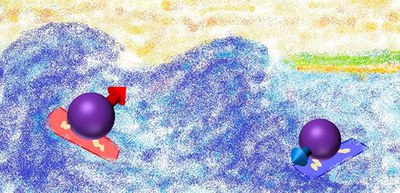
Negative resistance generated in superconducting monolayer NbSe2 induced by forced oscillation: A stride toward superconducting quantum computers
A group of researchers from Osaka University and The University of Tokyo has demonstrated that the irradiation of surface acoustic waves (SAWs) with gigahertz (GHz) frequencies induced a negative resistance at the zero bias current limit, i.e., an opposite voltage drop with respect to the current direction, in a superconducting gap of thin 2H-NbSe2 films.
Thin film electronic devices can be used in many industrial fields. Since the discovery of graphene (a one-atom-thick layer of graphite) in 2005, it has become easy to make a one-atom-thick layer thin film with sticky tape. Recently, it was experimentally clarified that a thin film exhibited zero resistance (as evidence of superconducting) and ferromagnetism.
Unlike epitaxial thin films, one-atom-thick layer thin films do not need to match the atomic lattice structures of the film and substrate, so various types of substrates can be used for depositing thin films. The SAW, an elastic wave traveling along the surface of piezoelectric substrate, is generated by applying an AC voltage to comb-shaped electrodes. SAW filters are used to eliminate particular frequencies from a signal in various electronic devices such as cell phones.
Research on controlling electronic or magnetic states in matter using SAWs is actively conducted. This group attached Niobium diselenide (NbSe2) thin films on a piezoelectric substrate Lithium Niobate (LiNbO3), creating comb-shaped electrodes on it. The negative resistance was observed only when the SAW of a few GHz was applied to the NbSe2 device. Under the SAW irradiation, the researchers experimentally measured negative resistance values.
They found that, below superconducting critical temperature (Tc) where zero resistance is observed, the amplitude of the negative resistance became larger by increasing the SAW power and decreasing temperature. They also found that superconducting transition and charge density wave (CDW) transition were realized only in the NbSe2 devices and that the negative resistance in the superconducting gap of a NbSe2 thin film on the LiNbO3 substrate was induced by the SAW irradiation. Their experiment indicated that the negative resistance was caused by the interplay between the superconductivity and the SAW-modulated CDW.
Negative differential resistances (NDRs) occur in semiconductors when the current flowing through the material decreases as the voltage applied to it increases. NDRs are used for amplifier and oscillator circuits as tunnel diodes (or Esaki diodes). The NDR has the negative differential value of the voltage and current, but the absolute value of resistance, namely a voltage divided by an applied current, remains positive.
This technique to generate negative resistances by applying SAWs to a superconducting thin film may make it possible to add a new function to quantum computers built with superconducting quantum circuits. The quantum state of SAW devices using a one-atom-thick superconducting thin film can produce a desired quantum state through the modulation of the superconducting state and negative resistance state by driving an external field such as the SAW.
Figure 1
Figure 2
The article, “Negative resistance state in superconducting NbSe 2 induced by surface acoustic waves,” was published in Science Advances at DOI: https://www.science.org/doi/10.1126/sciadv.aba1377.

